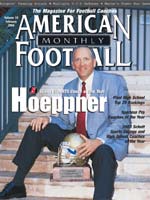AMERICAN FOOTBALL MONTHLY THE #1 RESOURCE FOR FOOTBALL COACHES
Article CategoriesAFM Magazine
|
Multiple 3-3-5 Defense...Harding University styleDefensive Coordinator/Defensive line, Harding University © More from this issue Following the 2000 football season our defensive staff was faced with the stark reality that the system/style of defense we were using was not only unproductive – it was unacceptable. Harding University has a history of physical, hustling, technically sound defenses primarily built around the philosophy of minimal fronts and coverages with an emphasis on execution and individual technique. Our dissatisfaction with our defensive productivity was compounded by the challenges presented by the offenses in the NCAA division II Gulf South conference.
Copyright 2025, AmericanFootballMonthly.com All Rights Reserved | ||||||||||||||





